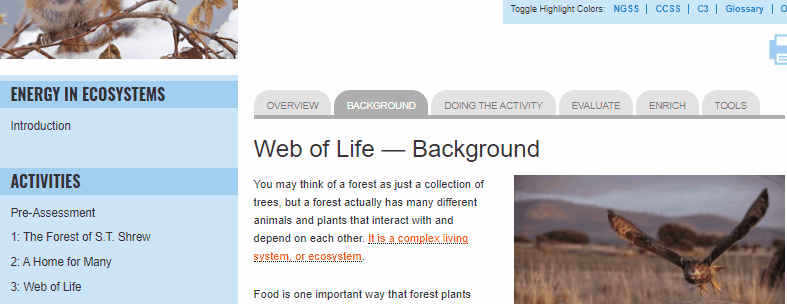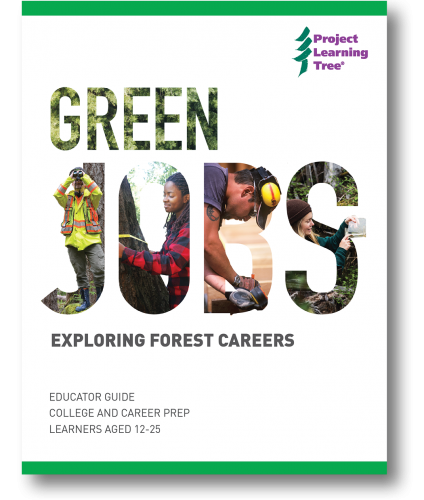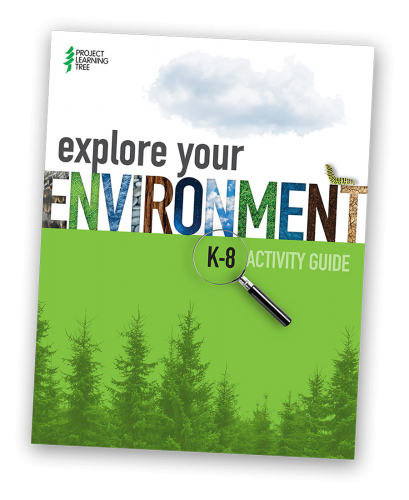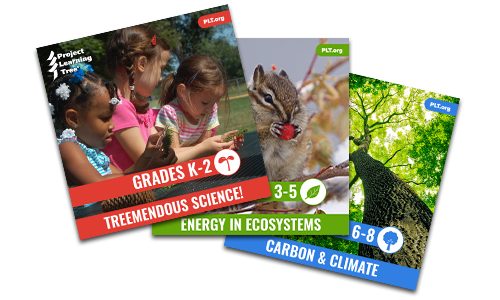 PLT and NGSS
PLT and NGSS
The Next Generation Science Standards (NGSS) define what students should know or be able to do at the end of instruction. To demonstrate learning, NGSS identifies Performance Expectations (PEs) that may be used to assess a student’s knowledge and proficiency. To meet benchmarks, students engage in the three dimensions of science— Science & Engineering Practices, Disciplinary Core Ideas, and Crosscutting Concepts—to explain a phenomenon or design a solution.
Project Learning Tree is committed to supporting educators in providing instruction that helps students meet science education standards. As such, PLT’s curriculum materials are correlated and designed with three-dimensions of science in mind, making them useful for educators even if their state has not adopted NGSS.
Correlations of PLT Materials to NGSS
Explore Your Environment: K-8 Activity Guide
Activities in the Explore Your Environment K-8 Activity Guide offer phenomenon-based learning, which involves exploring the real world through learner-centered, multidisciplinary investigations that promote inquiry and problem solving. Download this NGSS Correlation Toolkit for the K-8 Activity Guide.
E-Units for Grades K-2, 3-5, & 6-8
PLT’s e-units are constructed around—rather than correlated to—targeted Performance Expectations within the NGSS. In other words, rather than just making the correlations fit into curriculum, PLT began with NGSS’s three-dimensional approach to design the e-units around targeted performance expectations for science.
In addition, the e-units are aligned with two other academic benchmarks: Common Core (ELA and Math) and The College, Career, and Civic Life (C3) Framework for Social Studies.
Within the e-units, the alignments for all three sets of standards are made explicit for teachers and displayed visually on the interactive instructional unit’s websites (see demo below.)

Many state standards use the national benchmarks as a basis for their own individualized standards of learning. With an appropriate level of understanding and professional development, teachers and administrators can easily draw connections between the national standards and their state subsets.
Get Treemendous Science! for K-2!, Energy in Ecosystems for 3-5, and Carbon & Climate for 6-8.
PLT’s Green Jobs: Exploring Forest Careers 
Green Jobs: Exploring Forest Careers supports the NGSS approach for three-dimensions of science, and advances the NGSS middle school Performance Expectation: MS-ESS3-3, namely that students should be able to apply scientific principles to design a method for monitoring and minimizing a human impact on the environment.
Download this PLT Green Jobs NGSS Correlations Toolkit. The Toolkit includes guiding questions, a list of science connections, and explicit NGSS correlations for each activity.
Other PLT Guides Connected to NGSS
- GreenSchools program: NGSS Correlation with PLT’s GreenSchools Investigations.
- Exploring Environmental Issues: Place We Live for grades 9-12: Crosswalk between PLT’s Place We Live and NGSS.
- Energy & Society for grades K-8: Crosswalk between PLT’s Energy & Society materials and NGSS.
PLT and NGSS: Built on a Common Foundation
PLT recommends the adoption and implementation of a three-dimensional approach as an effective and research-based approach to science education. Furthermore, PLT is built on many of the same guiding principles as NGSS. Below we outline some of the major shifts for meeting science benchmarks within NGSS, and the many ways PLT supports them. These are excerpts from PLT and NGSS: Built on a Common Foundation. Read the paper (last edited Sept 2014) for more details and specific examples.
1. Focus on Both Knowing and Doing
The new science standards emphasize not only what students are to know about science, but also what they are to be able to do. PLT’s materials meet this requirement by guiding the learner through the process of awareness, understanding, challenge, motivation, and action through hands-on investigations and active involvement. PLT’s activities include content and application, as well as assessment opportunities in which students are asked to apply and demonstrate what they have learned.
For example, “Forest Invaders” from the high school module Exploring Environmental Issues: Focus on Forests, supports NGSS performance expectation HS-LS2-7 in a number of ways. This performance expectation specifies that students should be able to design, evaluate, and refine a solution for reducing the impacts of human activities on the environment and biodiversity.
While no single classroom lesson can fully address a performance expectation, “Forest Invaders” provides a launchpad for a deep three-dimensional dive. In this PLT activity, students explore why invasive species might cause problems for forest ecosystems, research different types of invasive species, investigate technologies to control a specific type of invasive species, and practice persuasive skills in debating which control method is superior. To apply what they have learned, students are challenged to take action by selecting an invasive plant or animal in their community and develop a presentation to inform others about the species and how to prevent its spread. As enrichment, students are encouraged to design and deliver an invasive species control project. As this activity demonstrates, PLT materials move students beyond content knowledge to application in an integrated context.
2. The Importance of Cross-Disciplinary Learning
NGSS includes seven Crosscutting Concepts that bridge the different science disciplines and allow students to connect different pieces of knowledge. PLT’s Conceptual Framework (which serves as the basis for the development of all its curriculum materials) was also designed to link concepts from different fields to deepen students’ understanding of science and the environment. There are many commonalities among the PLT Conceptual Framework themes and NGSS Crosscutting Concepts, namely patterns, systems, structure and function, and stability and change.
3. Interconnected Nature of Science
NGSS states that science education should reflect the interconnected nature of science as it is practiced and experienced in the real world. PLT activities are interdisciplinary by design and help students experience the interconnected nature of science through hands-on investigations. For example, in PLT’s GreenSchools: School Site Investigation, students learn many science concepts and discover how engineering practices can be applied to solving a problem on their school grounds. They also are exposed to many NGSS crosscutting concepts.
4. Content Depth and Application
NGSS emphasizes not only a deep understanding of content, but also the application of it, and the importance of students engaging in scientific practices directly. PLT’s individual PreK-8 activities can be organized into thematic, process-based units, allowing students to delve deeper into a single content area of interest. PLT’s secondary modules each focus on a specific topic, such as forest ecology or biodiversity, and suggest opportunities for students to apply what they’ve learned. All PLT lessons engage students in scientific practices through hands-on and student-directed learning, such as field investigations, experiments, data collection and analysis, debates, role play, and problem solving. This approach to teaching and learning helps students delve deeper into content and explore real-world applications of what they’re learning. In addition, PLT provides authentic assessment ideas for every lesson. These assessments require students to demonstrate what they’ve learned through performance-based applications, rather than to simply state what they’ve learned.
5. Scientifically Literate Citizens
NGSS supports the development of the next generation of decision-makers who will help solve the many science and technology challenges of society today. NGSS indicates that a scientifically literate person understands the core ideas in each of the major science disciplines and can apply them. This emphasis is aligned with PLT’s mission to develop environmentally literate citizens. PLT’s materials engage students in hands-on, interdisciplinary activities that are designed not only to teach science concepts, but also to develop problem-solving skills and apply them to environmental issues. Through PLT activities, students learn how to apply scientific processes and higher order thinking skills to address local, regional, and global environmental issues. They also learn why it is important to protect the environment through activities such as recycling, water conservation, and energy use reduction.
6. Alignment with Common Core
NGSS underscores the need for scientifically literate students to be able to communicate their understanding of science. To support this, each NGSS standard includes content connections to the Common Core State Standards for English Language Arts and for Mathematics. PLT activities are multidisciplinary, supporting students in building necessary skills in science, English Language Arts and Mathematics. For example, many PLT activities engage students in informational and close reading, argumentation, and analyzing and interpreting data. PLT challenges students to conduct research, prepare and give presentations, or debate various viewpoints. A correlation of PLT’s PreK-8 Activity Guide to the Common Core State Standards can be found online.
7. Professional Development Supports Implementation
NGSS-aligned professional development is critical to the success of adopting and implementing the science standards. Since its inception, PLT has always had an emphasis on professional development as an integrated and integral program component. Each year, approximately 15,000 educators across the country attend PLT professional development events, many of which are tailored specifically to helping teachers meet the Next Generation Science Standards.
Read more: PLT and the Next Generation Science Standards: Built on a Common Foundation
More NGSS Resources
- Achieve and the Teaching Channel’s video overview of NGSS innovations and three dimensions.
- YouTube Videos – Scientific and Engineering Practices



